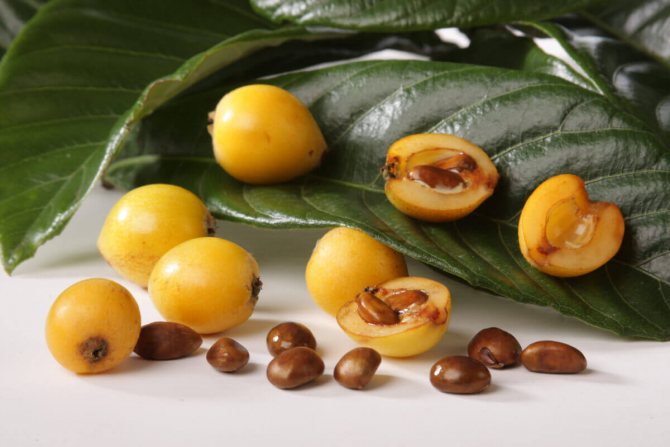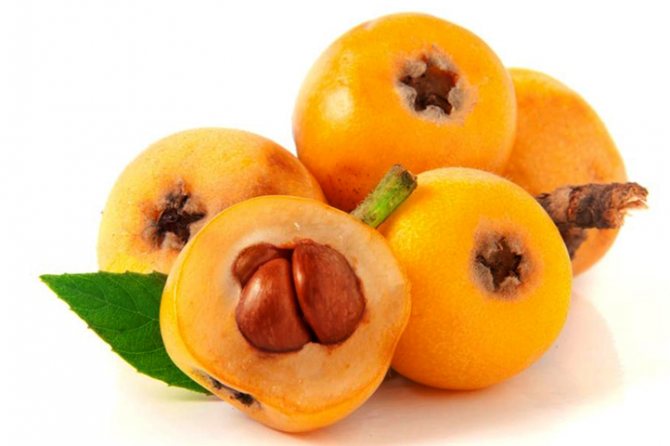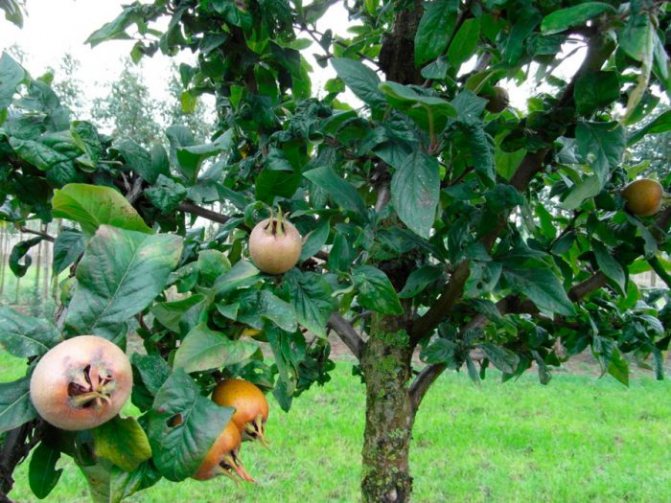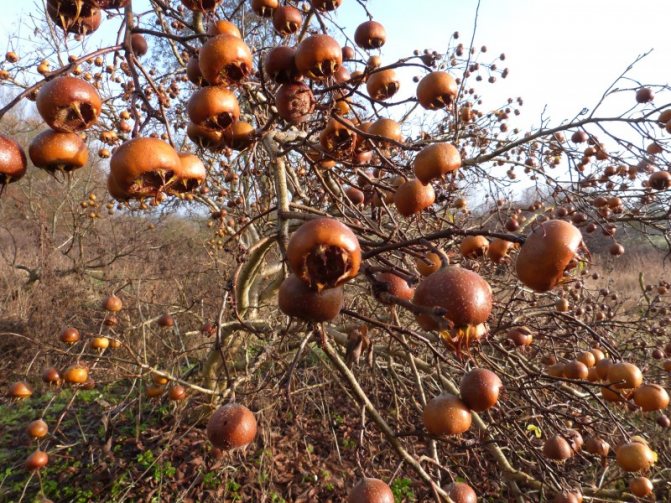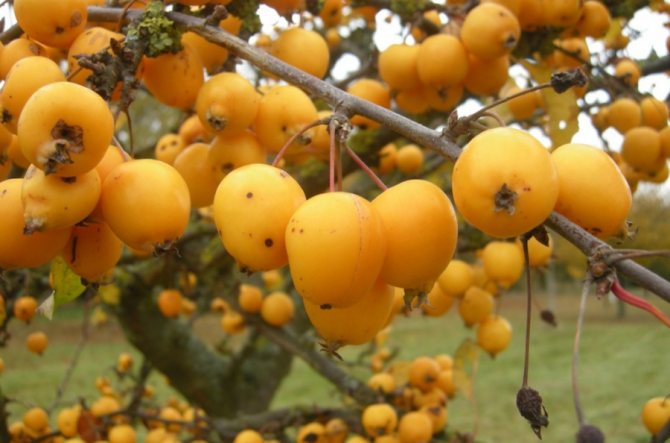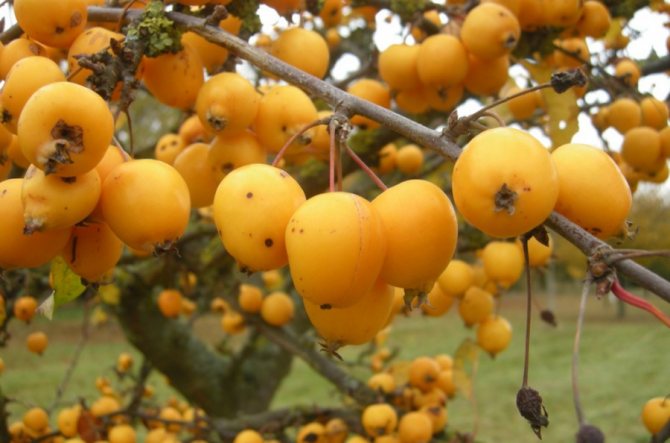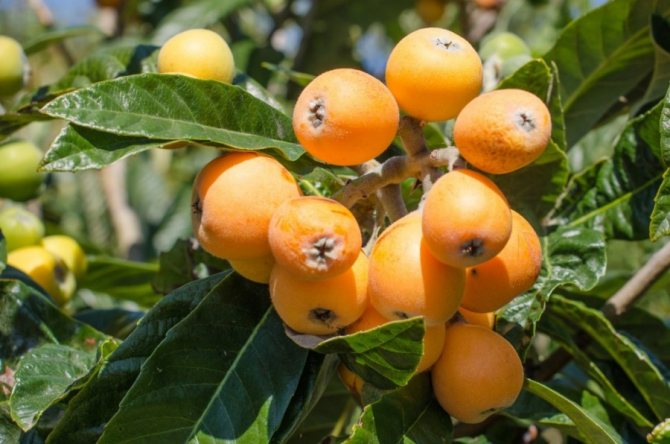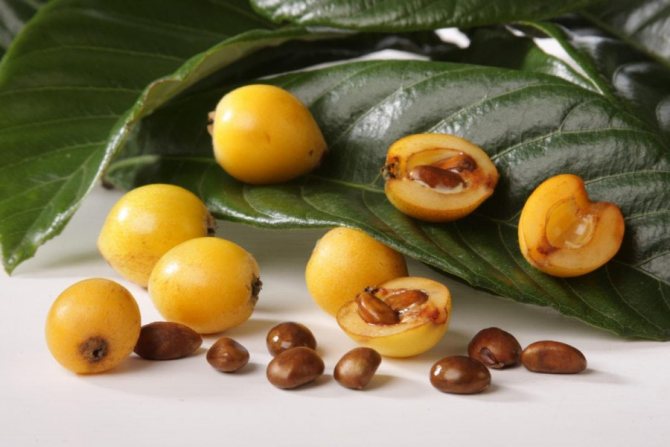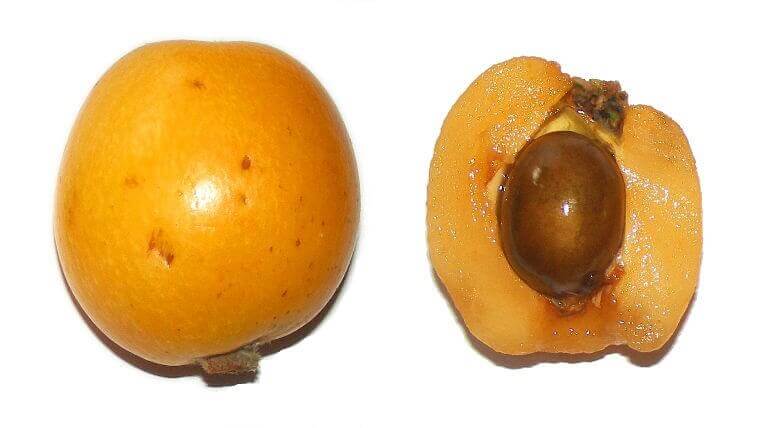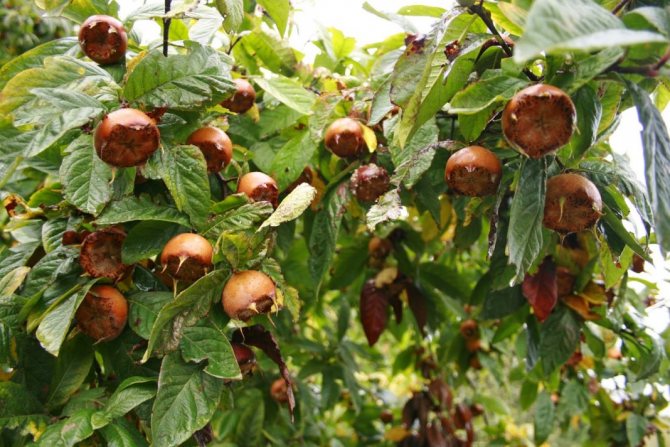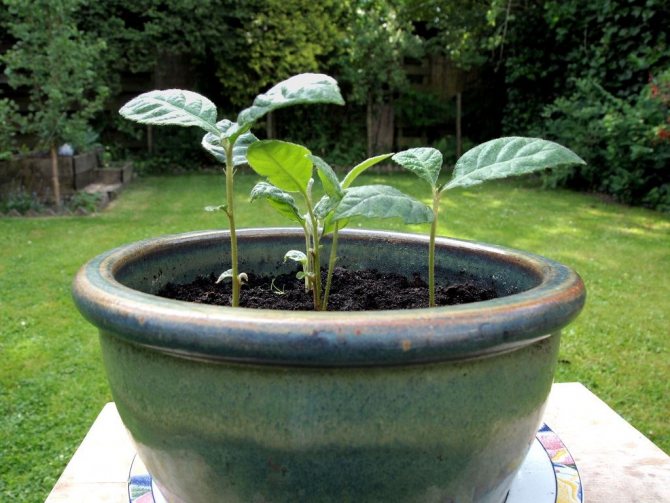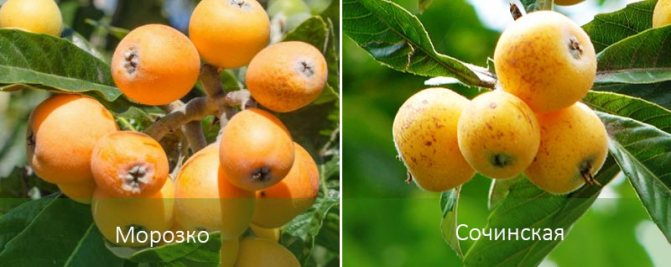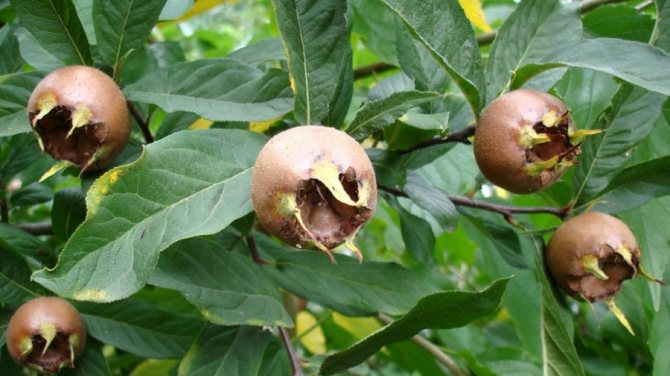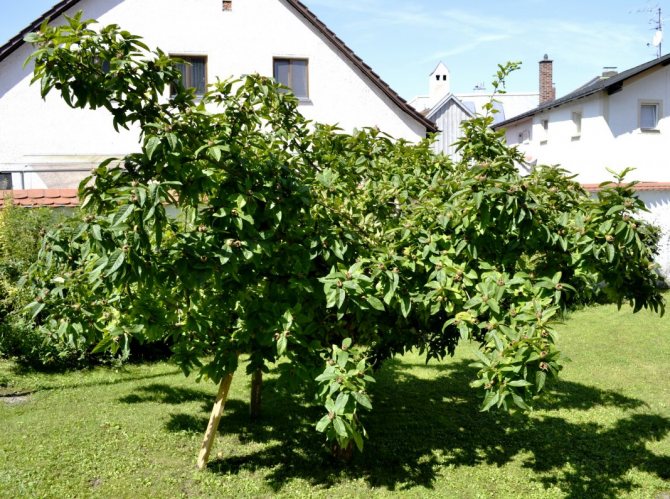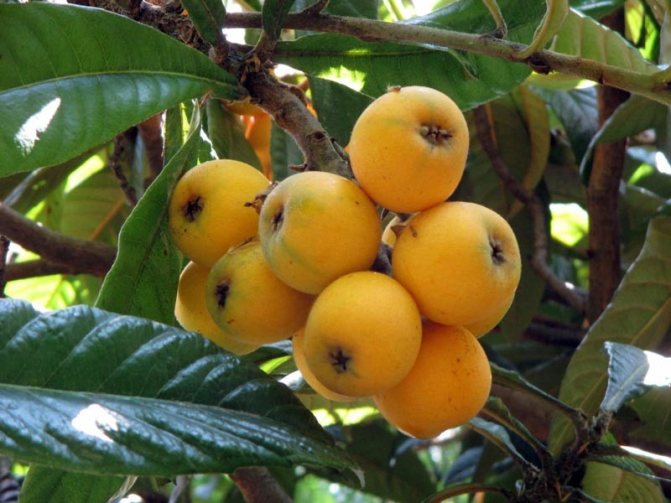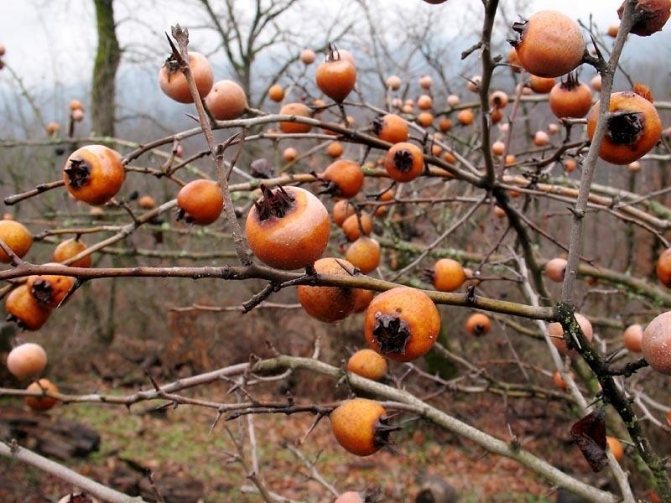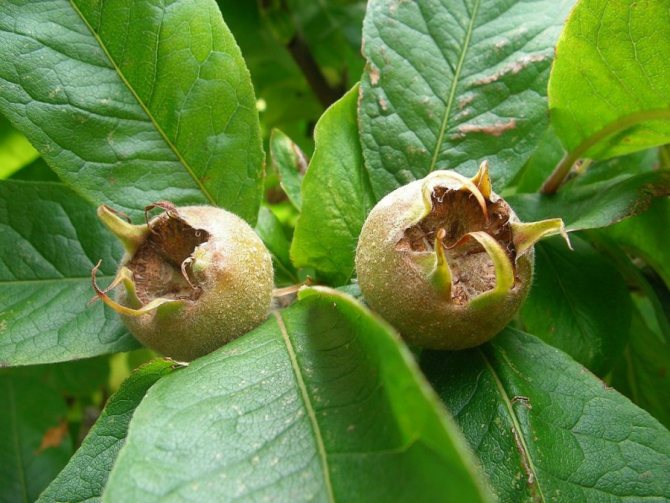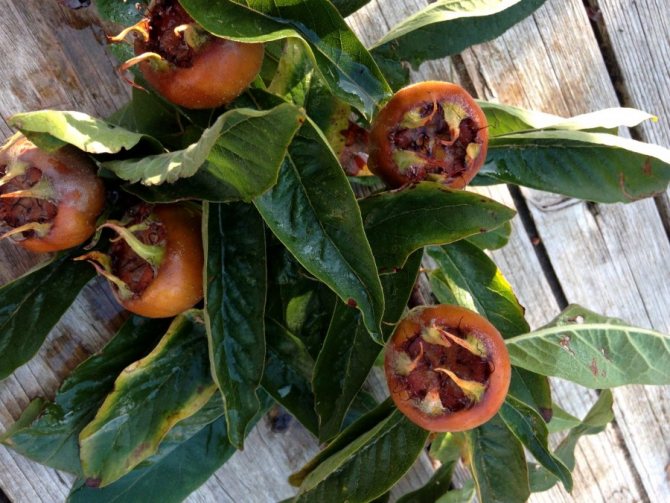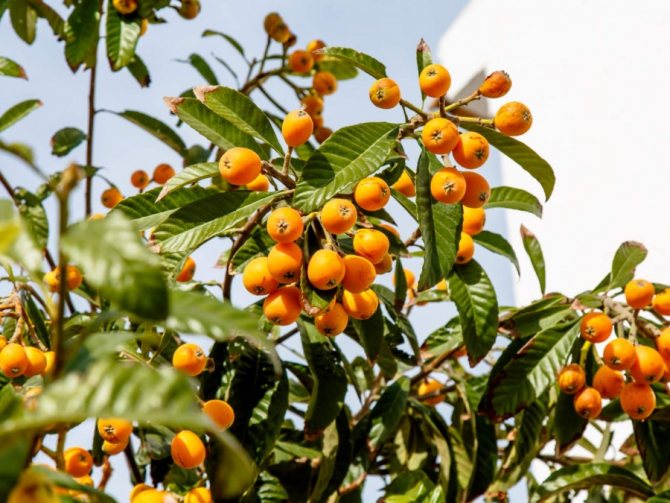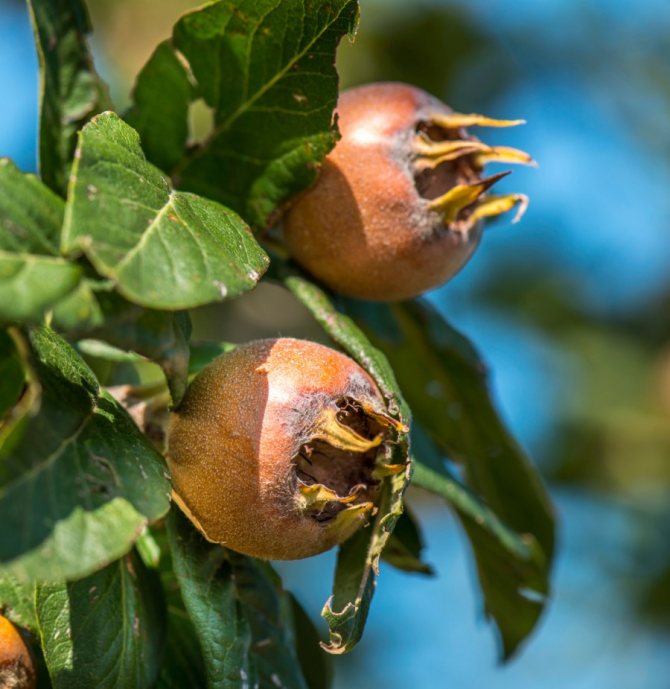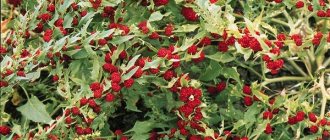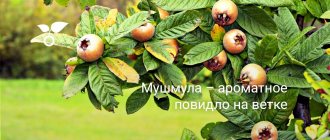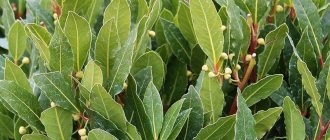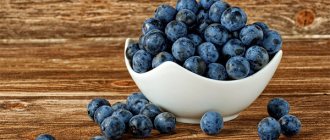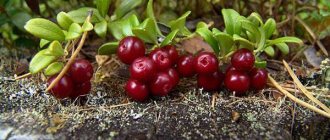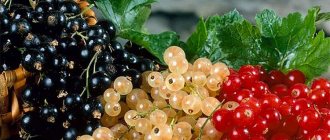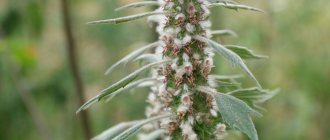general description
Medlar (Turkish muşmula) is a whole genus of plants, which includes almost 30 species. However, there are two main cultivated types of medlar: Germanic and Japanese.
The Germanic medlar was known to mankind for more than 1000 years BC. In the territories of Ancient Babylon, Mesopotamia, it was freely traded, on ships it was transported west to Ancient Greece and Ancient Rome. It was from here that the medlar came to European lands. Today, the Germanic loquat grows in the Balkans, Asia Minor, the Crimean mountains, Transcaucasia, Armenia, Algeria, Azerbaijan, Greece and northern Iran. The tree is quite picky and grows well only in dry, sunny places and on slightly acidic soil.
The German medlar has a round shape, slightly flattened along the axis with expanded sepals at the end. The fruit is small in size (2-3 cm in diameter), red-brown in color. The unripe fruit is quite hard and sour. Medlar ripens only after the first autumn frosts or after laying for a month. At the same time, the fruits lose moisture, become wrinkled, but at the same time soft and sweet.
The homeland of the Japanese medlar is the subtropical territories of China. It was from here that the plant got to Japan, and then in the 19th century. was brought to Europe. Medlar is cultivated in Georgia, India, USA, Ukraine, Southeast and South Asia and in the Himalayan mountains. This species is closest to quince, pear and hawthorn. The plant begins to bloom in the fall and the fruits ripen in the spring between May and June. They have a pear-shaped shape with a diameter of up to 10 cm. The color of the peel is orange-brown, the flesh is juicy, sweet and sour in taste. Inside each Japanese medlar there are large dark brown bones from 1 to 5 pcs.
Storage and use of medlar
The medlar should be stored in a dark, cool place, so that the fruits do not come into contact with each other. Medlar is eaten mostly fresh, but in the regions of growth, jam, preserves, marmalade, marshmallow, juices, compotes, as well as wine and liqueur are prepared from it.
Nutritional value per 100 grams:
| Proteins, gr | Fat, gr | Carbohydrates, gr | Ash, gr | Water, gr | Calorie content, kcal |
| 2,1 | 0,8 | 14 | 0,6 | 80,5 | 52,5 |
Medlar: what is this fruit
Botanically, the fruit plant belongs to the Pink family. Historically, China is considered its homeland. There are two types of plants - Japanese and Caucasian, or Germanic, medlar. Despite belonging to the same genus, they are fundamentally different from each other. Fresh fruits of the Japanese fruit plant are most often used, Caucasian medlar can be found in confectionery.
Outwardly, the yellow-orange fruit is very similar to an apricot - it is easy to confuse them. It is called by different names - lokva, or shesek, or biwa. In all cases, the same fruit is meant.
The plant belongs to the category of evergreens, therefore the medlar tree is often used in landscape design. But, since the great benefits are hidden in the fruits of the fruit, it is interesting to consider it from a culinary and medicinal point of view.
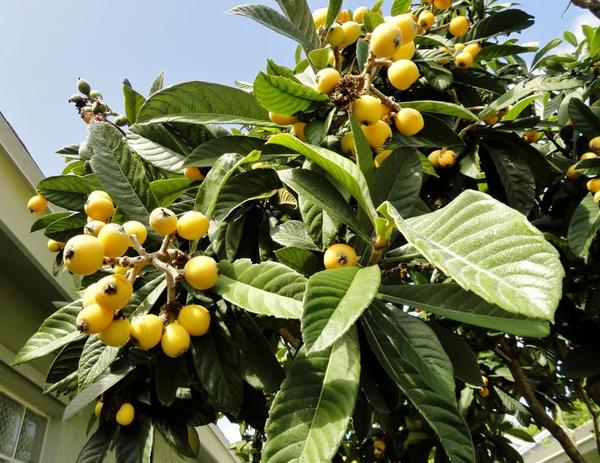
Description of the Caucasian medlar
The two main types of medlar are most widely represented - the Japanese and German varieties. The second name of the Germanic species is Caucasian. It differs from the Japanese in time and ripening period, shape and size of the fruit.
The Germanic (Caucasian) medlar grows in a climate with fairly short summers and cool winters. Its bloom begins in early winter. In this, it is similar to most types of fruit trees and is fundamentally different from the Japanese medlar, which begins to bloom in early winter.
After flowering, which lasts about a month or more, the fruit sets in. It is at this time that the tree most needs care and feeding. Gardeners growing medlar are aware of this and spray the tree every day, make sure that parasites do not appear on the leaves and bark of the plant.
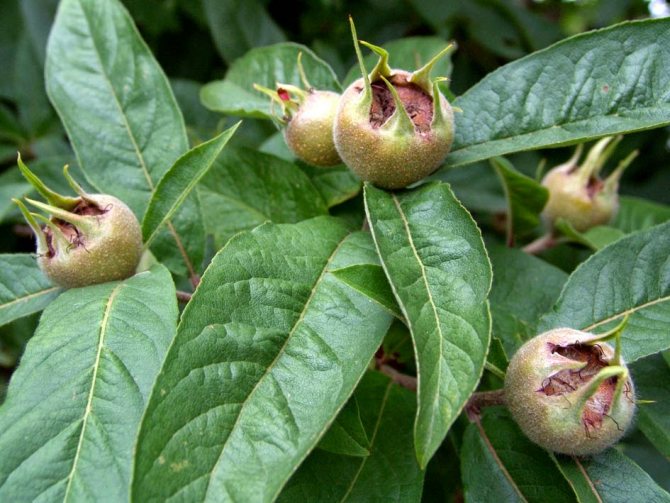

Leaves are especially vulnerable to scale insects and false scales. These parasites are capable of destroying an entire plantation of fruit trees in a short time. It is extremely difficult to deal with them, because they have good, stable immunity to a wide range of pesticides and chemicals. In addition, spraying with poisonous substances is not favorable for the tree during flowering and fruit ovary.
Composition and calorie content
The benefits of medlar are hidden in its composition - the pulp of the fruit is filled with the vitamins most necessary for human health. Having eaten a few berries, you can get in large quantities:
- vitamin P and PP;
- vitamin C;
- vitamin A;
- trace elements sodium and potassium.
Also, the fruits of the plant contain natural sugar, pectins, natural fruit acids.
The energy value is very small - there are only 47 calories in 100 g of the fruit of the delicious Japanese medlar. Nutritional useful properties are represented mainly by carbohydrates, of which there are more than 10 g in the medlar. Small portions are occupied by proteins and fats - 0.43 g and 0.2 g, respectively.


Japanese variety of the fruit
And now about the second variety. What does Japanese medlar taste like? The sweet and sour juicy pulp of the fruit is a little more interesting than that of its Germanic "relative". It is close to hawthorn, pear and quince. In Europe, this medlar appeared in the 19th century. Today it is cultivated in the Himalayas, South and Southeast Asia, Ukraine, USA, India and Georgia. Fruits ripen in late spring. They differ in a pear-shaped shape with a diameter of up to ten centimeters. Each fruit contains from one to five seeds.
What is useful medlar for the body
How exactly is the benefits of an exotic fruit manifested? Fruits saturated with vitamins contribute to:
- normalization of blood pressure;
- strengthening of blood vessels;
- improving heart rate;
- improving the body's ability to self-regenerate;
- increased immunity.
Also, the fruit can serve as a prophylactic agent against oncology. The beneficial properties of exotic fruits rejuvenate the body and bring vigor.
Advice! Even after cooking, the fruits retain their valuable properties - for example, the loquat compote is useful. But in order to maximize the benefits, it is recommended to eat the fruit fresh.
For men and women
The product provides benefits for men and women interested in their attractiveness and reproductive health. Its fruits allow you to maintain youth longer, improve the condition of the skin, insure against the appearance of early wrinkles.


The positive effect on blood vessels is significant for women, since it facilitates the periods of menstruation. And for men, the benefit is expressed in the fact that the fruit helps to maintain potency and prevents the development of prostatitis.
Protection of medlar from pests and diseases
The German medlar is extremely rarely affected by pests and diseases. Gardeners note that of the pests, the medlar is damaged by aphids, scabbard. From diseases - fungal diseases, including soot fungus, brown rust. Damage by other pests and diseases is manifested in some cases and practically does not harm plants.
For prevention, the trees and shrubs of the German medlar are treated with 3% Bordeaux liquid after the leaves are shed in autumn and spring before bud break.It is better not to use other chemical treatments, but to use, if necessary, biological products:
- bioinsecticides - actofit, boverin, lepidocid, bitoxibacillin and others.
- biofungicides - mycosan, trichodermin, phytolavin, phytosporin, glyocladin and others.
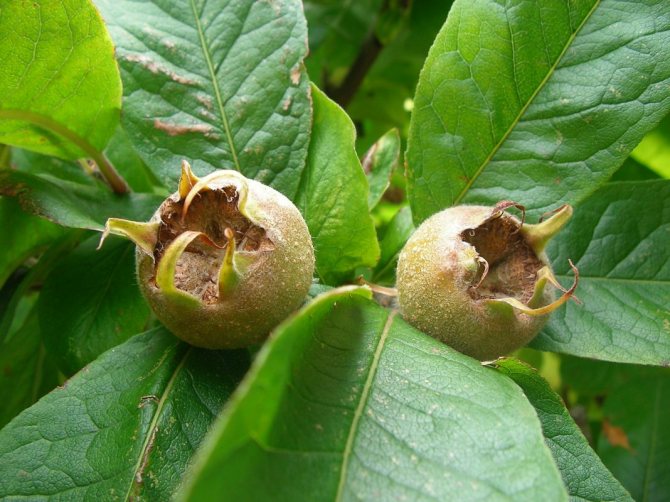

German medlar (Mespilus germanica). <>
The use of medlar in traditional medicine
The benefits of the fruit do more than just improve overall health when consumed regularly. The fruits are used as a folk remedy for the targeted treatment of ailments. The Caucasian medlar has a particular benefit, the fruits of which:
- serve as a good laxative - if you choose a ripe medlar;
- stop diarrhea - if you eat slightly unripe fruits with an upset stomach;
- quickly increase insulin in the blood and lower sugar levels;
- help to cough up in case of colds, as they thin phlegm;
- serve as an effective diuretic;
- equalize blood pressure with its sharp drops.
The fruit is effective as a cleanser - adding it to the diet removes cholesterol, toxins and even heavy metals from the body. Medlar tincture can be a good pain reliever for abdominal cramps.


Use in cosmetology
Since the fruits of an exotic fruit contain many astringent components, antioxidants and vitamin A, medlar is actively used to create cosmetic masks and creams. Its extract can be found in many products aimed at smoothing wrinkles and eliminating acne.
You can also create home care products from Japanese and Caucasian medlar. For example:
- use the grated pulp of ripe fruits, carefully crushed seeds and honey to prepare a gentle scrub;
- mix the pulp of several berries with peach and olive oil for a nourishing moisturizing mask.
If you apply masks with medlar on your face at least 2-3 times a week, soon the skin will become much softer and more elastic, and fine wrinkles will be smoothed out without a trace.
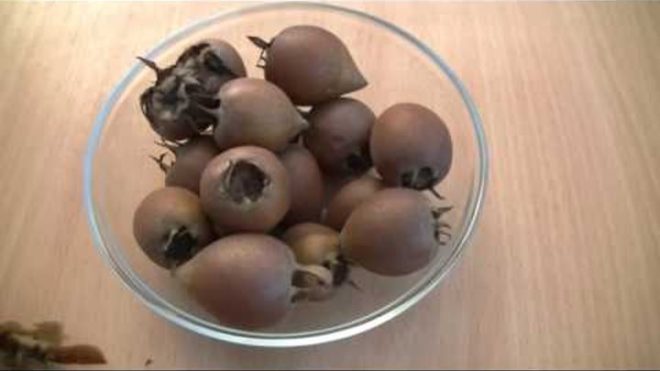

How to grow at home


the plant is unpretentious and takes root well on the backyard
Growing a plant in the garden
The best option is to grow an exotic plant from seedlings purchased in advance from the nursery.
A hole is dug in accordance with the size of the seedling, drainage and complex fertilizer are placed there. After placing the plant, the hole is covered with a peat substrate.
The soil in the area where the medlar grows should not be acidified. The plant loves neutral soil and moderate watering. Young seedlings are fed with complex fertilizer once a month, adults - 3 times a year.
Timely pruning of damaged shoots, treatment with means for worms, aphids and scale insects are of great importance in the process of caring for the plant.
Plants must be planted at a distance of 1.5-2 m from each other.
Medlar propagates by layering, cuttings and seeds.
To grow a plant from seeds at home, you must:
- choose a container with a volume of 1.5-2 liters;
- fill it with a substrate for flowering plants, place 5 seeds at a depth of 3-4 cm;
- cover the container with plastic wrap, not forgetting to arrange daily ventilation;
- when the sprouts reach 3 cm in height, you need to plant them in different pots.
Planting plants in open ground is carried out in the spring.
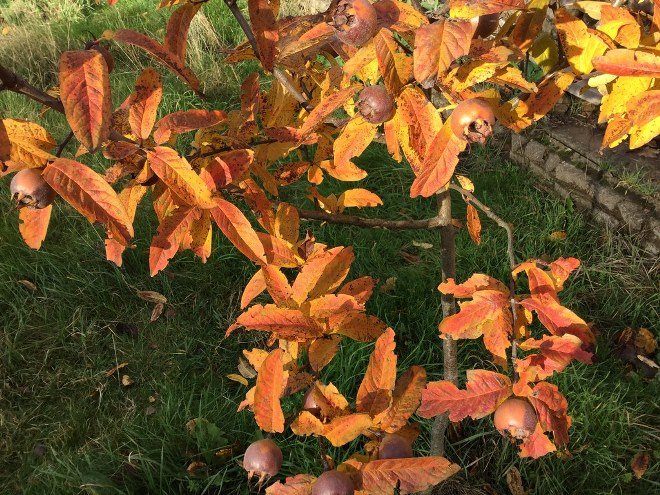

use the plant for decorative purposes to decorate the landscape
Medlar leaves: healing properties
For treatment and skin care, not only the pulp of ripe fruit is used. A great benefit lies in the leaves of the plant of both varieties - Japanese and Caucasian. The leaves also contain a lot of valuable substances - antioxidants, tannins, absorbents.
- A decoction of the leaves of the plant saves with diarrhea.A handful of leaves are poured with boiling water, insisted for 4 hours, then filtered and drunk - a few sips half an hour before meals.
- You can take such an infusion with a healthy intestine - just for prevention. The tool will help lower cholesterol and remove toxins.
- Tincture from the leaves of an exotic plant has a mild analgesic and anti-inflammatory effect. It will be of great benefit for joint ailments.
- A decoction based on medlar leaves is good for colds. The tool fights viruses and infections, helps to reduce fever.
- You can wash your face with a decoction of the leaves of the fruit plant in the morning. Tannins in its composition will even out the relief of the skin, make it a little lighter, cleanse and narrow the pores.
Important! Only mature leaves can be used for medicinal purposes - young leaves of the plant contain toxic substances.


Biological features
Caucasian medlar (German) - in its natural state, a deciduous tree 3-6 m tall with a pronounced trunk reaching up to 20 cm in diameter, but in culture it can also be represented as a shrub.
There are thorns on the shoots. The leaves are dark green, large, usually bloom at the end of April. Flowers are formed on the tops of short shoots, they are solitary with a 5-petal corolla, reaching 3-4 cm in diameter; the flowers that have just blossomed are white, later they acquire an original pinkish tint, while the greatest decorative effect is provided by numerous long stamens with bright pink anthers.
The medlar blooms at the end of May, the maximum flowering duration is 19 days. The fruits, which are close to apples in their internal structure, ripen in autumn and become ready for consumption at the end of the season and in winter.
Their size can range from 2-3 to 7 cm in diameter, the shape of different varieties is also different - it can be apple-shaped (in this case, they can be easily confused with real apples, "for some reason" collected in a small bunch), spherical, pear-shaped , reverse conical and other configuration. Unripe fruits are dirty green, the color of ripe ones depends on the variety (from yellowish brown to reddish brown and deep brown).
One fruit contains up to 5 seeds. The flesh is usually brownish, sweet and sour. The fruits can remain on the branches throughout the winter.
The Caucasian medlar (German) is winter-hardy enough to grow even in temperate latitudes, and relatively late flowering keeps its flowers in many regions from the effects of spring frosts.
The advance of this culture to the north is hindered by the southern long growing season (until the first autumn frosts), which can cause young shoots to suffer in cold winters. However, medlar tolerates pruning well, therefore, to avoid trouble, it is enough to better insulate young trees (the loss of some of the shoots for adult specimens is not so dangerous).
Japanese medlar (lokva) - evergreen (ie, not shedding leaves for the winter) tree 3-5 m high (some specimens can reach 8 m). Shoots are covered with dense reddish-gray pubescence, in which small bunches can be distinguished.
The leaves are large, up to 25 cm in length and up to 7-8 cm in width, oblong-oval, the upper part of the leaf plate is dark green and glossy, the lower is greenish-gray, light and velvety from strong pubescence.
But the most important distinguishing feature of this medlar is that it blooms and bears fruit at completely different times than other garden plants: it blooms from September to March, and its fruits ripen in May - early June, that is, when the fruits of other crops not yet.
The inflorescences (brushes) of the medlar are also covered with pubescence, even thicker than the shoots.Its flowers are white, yellowish or creamy (the color depends on the variety), very fragrant (the aroma resembles that of almonds).
Fruits are most often pear-shaped, but in different varieties they can be spherical, ovoid, oval and flattened, 8-12 of them ripen in one cluster (usually there are more flowers). Fruit weight ranges from 20 g in some varieties to 100 g in others (their size reaches 7-8 cm in diameter).
Medlar in cooking
The simplest way to use the fruit in cooking is to use the fresh fruit of the Japanese medlar as a light dessert. But the berries of an exotic plant can be used in another way. For example, delicious compotes are cooked from them and juices are made, in which all the benefits of fresh fruits are preserved.
You can make jam from medlar - berries by weight should be exactly 2 times more than sugar. To taste, you can add additional ingredients to this jam - for example, lemon, cinnamon or cloves.
The Caucasian medlar is especially often cultivated. This is due to the fact that fresh sour berries are not as pleasant to the taste as the fruits of the Japanese medlar.
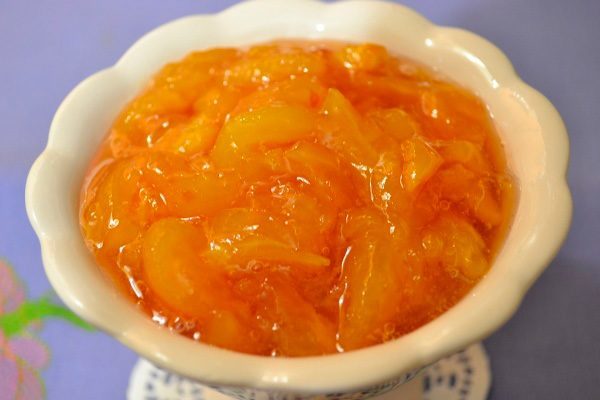

- Medlar is a common ingredient in a variety of desserts.
- The berries of the plant are found in cakes, pastries and pies.
- Cut berries are often added to salads if you want to sweeten them a little.
- Meat dishes in combination with pieces of this fruit become very unusual.
The benefits of medlar leaves
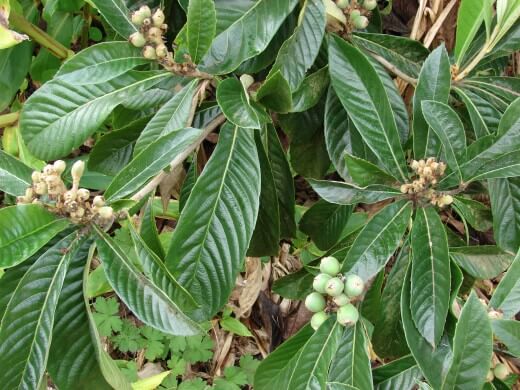

The leaves of this tree have many medicinal properties. An extract from them or a decoction is used for:
- strengthening immunity;
- treating diabetes (increases the production of insulin);
- promoting the health of the pancreas;
- cleansing the liver;
- treatment of skin inflammation (added to creams);
- fight against viral diseases;
- getting rid of depression;
- improving the condition of people with HIV.
How to eat medlar fruit
When faced with exotic fruits for the first time, many people ask themselves the question - how to eat an unusual fruit correctly?
- Before use, it is customary to cut the fruit in half and remove the bone from the core.
- If the fruit is unripe or belongs to a variety with a high density peel, then it is cut with a knife so as not to spoil the impression of the fruit.
- It is also recommended to remove the peel with ripe berries, but if it is rather soft, then this is not a prerequisite.
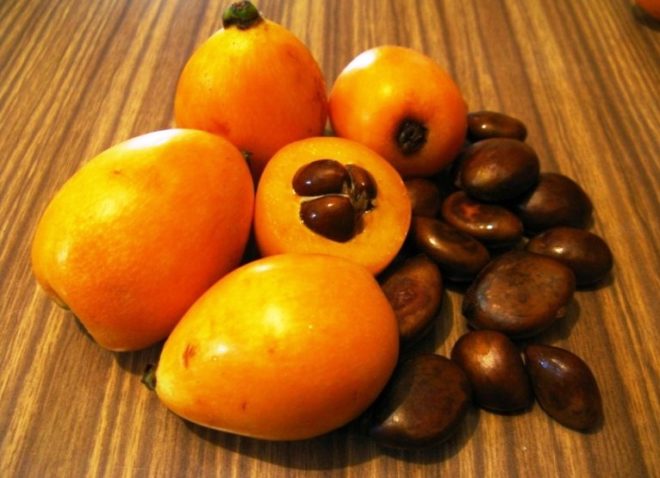

Harm and contraindications
For most people, the fruit is only beneficial. But he also has contraindications.
- Eating exotic fruits is not recommended for chronic stomach problems - ulcers, gastritis, pancreatic diseases. Like many other fruits, medlar is highly acidic and can provoke exacerbations.
- Before eating the fruit, you need to make sure that it does not cause allergies. They check it in the standard way - they literally try 1-2 berries and wait several hours, observing the reaction of the body.
Attention! The fruit will be harmful even in the absence of contraindications if you eat too many fruits. The average daily allowance for an adult is only 5-6 pieces.
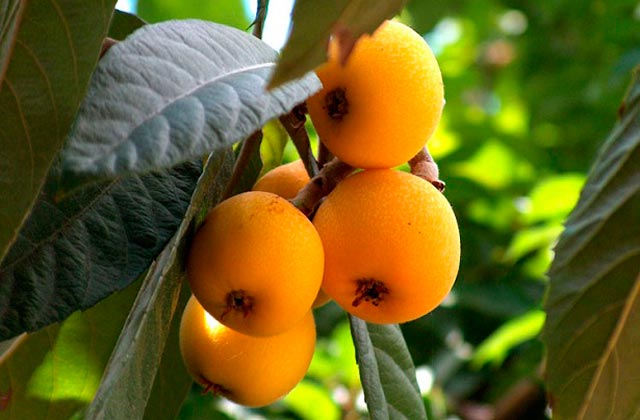

Harmful properties
In the seeds and leaves of the medlar, the researchers found mandelic acid. It is converted into cyanide as a result of metabolic processes. In addition, the seeds contain a substance that, in case of an overdose, causes shortness of breath and vomiting. And an excessive enthusiasm for tea from medlar can cause food poisoning. You should also be careful with young leaves of this tree - they contain a substance that causes headaches. Unripe fruits are dangerous for people with stomach ulcers or inflammation in the pancreas. In addition, this fruit can cause allergic reactions. Introduce into the children's diet also with caution, starting with 1 fetus per day.



